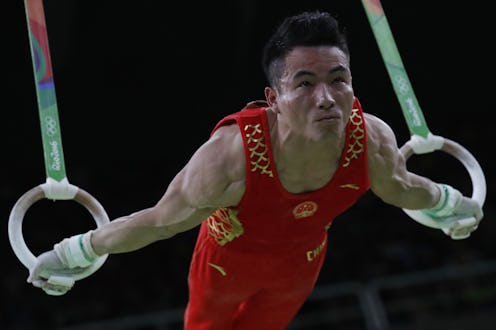News
Female Gymnasts Don't Have As Many Events As Men
If you've tuned into the men's gymnastics events throughout the Rio Olympics, you may have realized they do a completely different routine than the women. There's no music for the floor routines, and they seem to focus less on flexibility and more on strength. But that's not the only difference. The apparatuses used don't match up, either. In fact, the only one in common is the vault, and of course, both men and women also do a floor exercise. You may have noticed there are six events for men, compared to just four for women. So why don't female gymnasts do rings?
The differences are blatant, and it seems like sexism is the answer behind this. In addition to the vault and floor routines, men have the horizontal bar, parallel bars, pommel horse, and rings. Women, meanwhile, have the balance beam and uneven bars. But it wasn't always this way. The 1936 Olympics, the first to include women, had just one set of gymnastic apparatuses, and women used some of them, as Dvora Meyers reported for Jezebel.
Female gymnasts competed for points for their overall teams (they didn't get their own medals for individual events) on the parallel bars, balance beam, and side horse vault. In 1948, women "even competed in a compulsory exercise on the rings," Meyers wrote. Meyers interviewed one of these women, Laddie Bakanic, a member of the '48 team. "When I was on the flying rings and I had to leave go I was scared cause there was nothing there but a cotton mat on the ground," Bakanic said.
By 1952, everything was different. This was the first year that women were allowed to compete for individual medals. Meyers didn't find any definitive explanation for why women's apparatuses changed, but here's what she thinks: "Very informed speculation suggests that it was a combination of women's physical attributes and gender norms that contributed to the apparatus selection."
Aimee Lewis of BBC Sport agrees:
Each event is designed to show off the gender's natural qualities. An opportunity for the flexible and graceful sequined-wearing female to sparkle and the biceps-bulging male to test his strength and power. Peacocking for both sexes, just through different means.
Over the years, though, the difference in gender norms and the physical strength of male vs. female athletes has become less of an excuse. It may be time to consider a reconfiguring of the sport to allow women to compete on more apparatuses, and for men to add music to their routine.
Consider this floor routine done by Paris McGee Jr., a junior on the Ohio State men’s gymnastics team. He recreated Laurie Hernandez's routine for the participants in the Ohio State gymnastics camp, complete with music, dancing, and more. There's no reason to keep the skills of the male and female athletes starkly separated when men can excel with music and women could surely compete on the rings.
